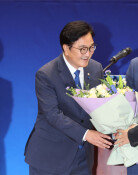China`s high-speed rail advance
The Jinghu high-speed railway linking Beijing and Shanghai will start operations Thursday. To be launched two years ahead of schedule, the rail is the world`s longest at 1,318 kilometers (819 miles), or three times the length of the Seoul-Busan high-speed railway. Ahead of the official opening, the Chinese government invited more than 200 foreign correspondents in Beijing to go on a test ride, bragging, Chinas high-speed railway technology is among the worlds best. Beijing`s pompous act is seen as an attempt to gain the upper hand in the bid for major high-speed railway projects around the world, including those in Brazil and the U.S. China will compete with Korea and others for the contracts.
In August 2008, China ushered in its high-speed rail era by opening the Jingjin high-speed railway linking Beijing and Tianjin one week before the Beijing Summer Olympics. China`s high-speed rail came four years after Korea`s and 44 years after Japans, but Beijing has since implemented large-scale projects in the sector at a rapid pace. °Slowly, slowly is no longer an expression that describes China as the worlds most populous country is engaged in a war of speed.
Behind the war of speed for high-speed railway in China are a number of weaknesses that Beijing is reluctant to show the outside world. One Chinese rail expert said, China operated a passenger train produced with foreign technology that allows for a speed of up to 300 kilometers (186 miles) per hour at 350-400 kilometers (217-248 miles) per hour, and the railway bed has subsided as much as 40 centimeters at certain sections. Critics say China should not blindly pursue goals, a practice that neglects safety and fuels fears over massive accidents resulting from sloppy construction work due to corruption. In 2007, 3,170 people were killed in railway accidents in China.
Despite these weaknesses and limitations, Korea cannot afford to underestimate China`s robust growth. The Middle Kingdom has emerged as the worlds second-largest economy, surpassing Japan. Going beyond its status as the world`s factory, China is closely tracing Japan and Korea in the high-tech area as well. A survey of economic experts conducted by the Federation of Korean Industries in June last year found that Koreas technological gap versus China in eight major export products was 3.9 years on average. Korea was leading China by more than four years in only two sectors: semiconductors (4.8 years) and automobiles (4.7 years). The gap in steel and chemicals was only 3.3 years. Since the survey was conducted a year ago, the gap is probably even narrower now.
Three years has passed since the development and beginning of test operations of the Korean bullet train KTX-Sancheon but 41 breakdowns have occurred, big or small, since the launch of commercial operations in March last year. If the Korean government, KoRail and related companies fail to renew their commitment, Korea will lose to China bids for high-speed rail projects in Brazil and the U.S.
Korea is a small country poor in natural resources, so if it is to keep emerging China at bay, education and investment that allows the fostering science and technology human resources are critical. Korea`s education and political circles, which are obsessed with halving college tuition and lacking efforts to boost educational competitiveness, make it difficult for the country to remain optimistic about its future. The Korean government and politicians should be wary of this harsh reality.







